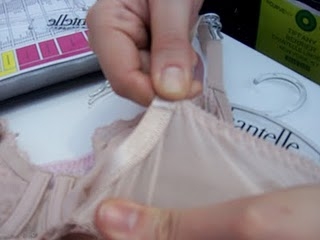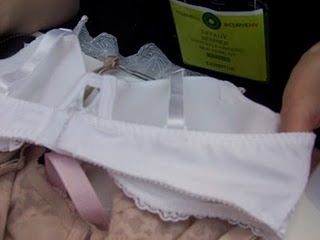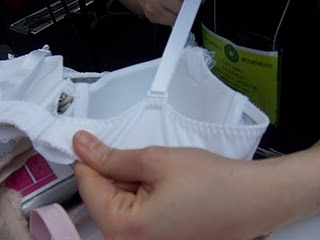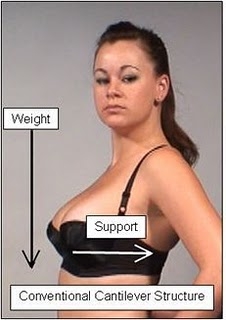Because some of the details that I’m going to describe in this series are present in all good bras, I’ll give more background about them here.
First, we’ve all heard that most of the support in the bra comes from the band, but I’ve always wondered how that could be. This picture from Don McCunn’s blog provides a great illustration for those of us who are visual learners.
Once we understand how the band supports our busts, we can see why the fabric used in the band is so important. When shopping for bras, compare the stretch of the fabric in back. If you buy an expensive bra, you should be paying for fabric that (i) is difficult to stretch; and (ii) returns to its original shape when you let go. An inexpensive bra can also provide great support, but you may need to replace it sooner. Tomima from Herroom gives a good explanation on her site.
Second, every quality D+ bra that I examined at Curve had a leotard strap back. Tiffany Berrier from Chantelle showed me the difference between the leotard strap back and the camisole strap back below.
 |
| Leotard strap back at rest |
 |
| The pull of the leotard strap is balanced in all directions. |
 |
| Camisole strap back at rest |
 |
| The pull of the camisole strap back concentrates the stress at one point, which can cause holes. |
I heard that Victoria’s Secret is going to offer D+ bras, but to watch out because they’re going to have camisole straps. This makes sense because they’re easier and therefore less expensive to create.
Finally, if you’re going to capitulate and buy a seamed bra, look for butted seams across the bust. I have no idea if my diagram below is even accurate, but here’s the point: butted seams, where two pieces of fabric are sewn together at the meeting point of their two creases, are less bulky than seams in which two pieces of fabric are sewn on top of each other. Feel free to add more if you know more about this!
It looks like I’ve run out of time to write about Prima Donna bras today, but when I do finally tell you what I learned about them at Curve, you’ll understand why the fabric, leotard straps and butted seams are important.


I am curious about your Victoria's Secret comment. By D+ do you mean DD+? Like E? F? etc? How do you know? When will this be?
It's not that I have any great desire to shop there… I never have liked them much. But that would be an incredible sign of progress in terms of bra fitting, availability, and cup size stereotypes.
Hi, Brittany. Yes, DD+, like E, F, etc. I heard this from a sales rep for another company, and it's all I know. It would definitely mean progress in the 3 areas you listed. I've been surprised at how they have avoided increasing their cup sizes for so long, but I think it has simply taken them a while to become convinced that we're not at the extreme end of the curve like they thought we were.
You referred to butted seams. This is actually called a pressed open seam. And I think what you referred to as sewn on top of each other would be a seam pressed to one side. The more layers you have in one place, the higher the "bump".
But there are other factors that play into the size of the "seam bump" as well.
The heavier and bulkier the fabric or more layers of fabric going into the seam will also make the seam sit higher.
Things can be done to reduce the visibility of the seam. A well pressed seam creases sharper and sits with less of a bump. Top stitching holds the seam allowances on the inside in place. Thinner fabrics will also make the bump smaller as they have less bulk. A big help is a one-piece overlay of lace that goes over the seam and helps to smooth and hide the seam.
One advantage of a seam in the cup, is that it goes right over the center of the breast and helps keep the cold-weather effect from showing. If preventing this effect is the only reason you wear a foam cup, then a seamed cup might be an option worth looking at. One with a lace overlay has a seam that is barely noticeable.
Ann
THANK you, Ann. I really appreciate your technical expertise. This makes a lot of sense.
Hiya there, wasn't sure where to put this, but I came over from Corporette. Re: Sheaths, I have it taken in on the seam in the sides from under the bust, usually through the top of the waist. I'm tall, so I usually don't need to take up the hem. It can be a bit pricey (think ~$50), and I use a tailor who also makes women's suits, so they are familiar with how things should look.
Hi, Becky. I so appreciate your contacting me because I realized I didn't give clear contact information on my Corporette comment. If you're open to my asking more questions, would you contact me at darlenecee@gmail.com? Thanks again!
I went bra shopping yesterday, and tried on a pretty, lace type bra, and wondered just how you keep the goods contained, LOL. Like in the first picture of your post. As soon as I'd bend over to pick up something, tie up someone's shoe, run when I hear the school bell…I'd love to wear those sexier bras, but they just don't fit in my t-shirt life I did find one smooth bra with a lace print, but it'd show under anything light coloured. Oh well…I still like reading about the better bras in hopes that one day I will have a different life
I did find one smooth bra with a lace print, but it'd show under anything light coloured. Oh well…I still like reading about the better bras in hopes that one day I will have a different life 
TracyKM, I only wear lacy full-cup bras for everyday. I save the balconettes for nights when I don't care if I spill out a little. However, I've noticed that I don't actually spill out–I'm just afraid I will!